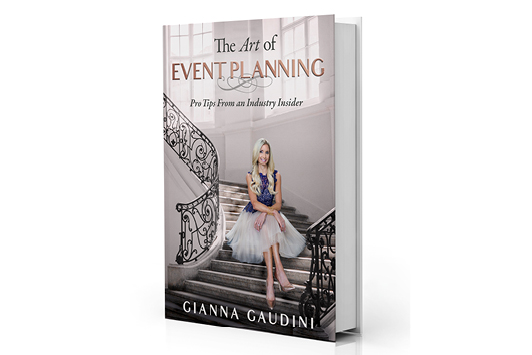
Gianna Gaudini once taped an executive’s shoes to his feet so he could skydive into the midst of an evening reception. Having spent almost a decade as an executive event producer for Google, Gaudini is currently global head of events for the Softbank Vision Fund and authored the recently released book
The Art of Event Planning: Pro Tips from an Industry Insider. Here, she shares her behind-the-scenes expertise.
Planning a promotional event can be daunting. Where do you start?
I like to think of producing events as the art of making memories — ultimately, you want people to remember your event and then respond the way you want them to.
The first question to ask is, “Why are you having the event?” Is it a product launch? A new store opening? Understanding how your event supports your goals will help you allocate your resources.
Then you need to define your target audience. It will help you determine everything from the color scheme to the food.
Focus on strategy, and if you need, get help with the creative elements. Check out Upwork, Fibre Creative and TaskRabbit for affordable services.
What is the biggest challenge when it comes to planning an event?
An event helps to build brand reputation. It is the physical representation of your brand. Everything you do — from the aesthetics to the communication — is going to convey what your brand is. And if you do it right, you’ll create brand evangelists who will want to spread the word and come back. But if you do it wrong, there can be negative consequences.
As a brand, you want to be sure you stand out. Come up with a couple of words, and then when you are planning your event, ask yourself if these words are coming through in your message.
Another important question to ask is if people could identify with your brand if the logo were removed. If this brand could be any other, you have to start over again.
How do you ensure that an event is on-brand?
The narrative of your event must be cohesive from the first touchpoint to the last. Everything you do has to be aligned with your brand message and who you are.
If you have the most beautiful brand in the world, your event should be Instagram-worthy. You’ll want to spend more on aesthetics and less on food. Is your brand service-driven? Then you have to convey the message “We care about you” with a personal greeting as soon as someone walks through the door. Are you promoting recycled diamonds and gold? Then be sure to avoid using plastic cups and other items that increase your environmental footprint.
How important is personalization?
Personalization is the secret sauce of events. Every guest should feel like a VIP. When you plan an event, put yourself in the shoes of the attendees. You know your goals, but you also have to figure out what your attendees want out of it. That means knowing as much as possible about them. It is not the quantity of the people, but the quality of the people that you are reaching on a personal level that is going to help build your brand.
Is there a pace to a successful event?
The first thing you want to do is build excitement around your event. I like to offer something helpful or new in advance. Take into account your target’s preferences regarding communication. Is a printed invite more appropriate than email? Whatever the medium, don’t come across as spammy.
Don’t be a lazy host during the event. Don’t expect that people will do what you want them to do. Have a call to action to see your new diamond line. And follow up: After the event, contact a customer with the message, “I noticed that you were checking out this jewelry line. Is there anything I can show you?” You might even consider adding, “Would you like to borrow it and see how it works with the outfit you described?” Go above and beyond what other brands don’t do.
Image: The Art of Event Planning by Gianna Gaudini. Article from the Rapaport Magazine - August 2019. To subscribe click here.